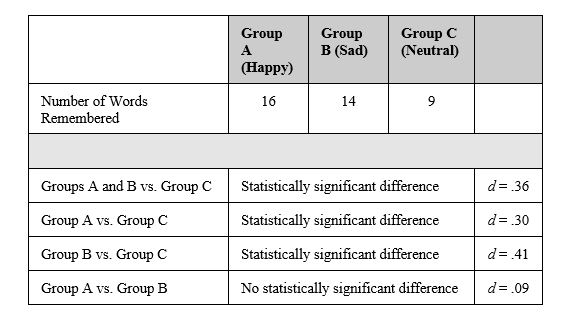RESEARCH STUDY 9.1
Dr. Lonsbary is a cognitive psychologist who is curious about how mood affects memory. She recruited 60 high school students and divided them into three groups. One group (A) listened to a 5-minute piece of music intended to make them feel happy (a song entitled "Don't Worry, Be Happy") . One group (B) listened to a 5-minute piece of music intended to make them feel sad (a song entitled "Alone Again") . One group (C) listened to no music and instead was asked to sit quietly for 5 minutes (thought to make them feel neutral) .
When a participant would come to her laboratory, she would greet the participant and then ask him or her to draw a card. If the participant drew a 1, 2, or 3, he or she was assigned to Group A. If the participant drew a 4, 5, or 6, he or she was assigned to Group B. If a participant drew a 7, 8, or 9, he or she was assigned to Group C. The participants were then given a CD to listen to based on their group assignment. The CD contained the song selection or 5 minutes of silence. There were no identifying marks on the CD indicating what was contained on the disc. They were then escorted into a different room, where they were greeted by a research assistant who conducted the experiment. The research assistant sat the participants in front of a computer screen and told them that a list of 25 words would be displayed on the screen. They were instructed to put the CD in the computer, put on the headphones, and listen to the CD while trying to memorize the list of words.
When 5 minutes had passed, the screen displayed a question asking them whether they felt happy, sad, or neutral. After the participant responded, a new screen was displayed asking them to type in all the words they could remember from the list of 25 words. All participants were given 3 minutes to type the words they remembered. In addition, all participants were given the same list of 25 words to remember. Afterward, the participant was thanked and dismissed. In response to the mood question, a majority of Group A participants said they were happy, a majority of Group B participants said they were sad, and a majority of Group C participants said they were neutral in their mood. Dr. Lonsbary found the following results in response to the number of words remembered.

-Refer to Research Study 9.1 above to answer the following question. Which of the following allows Dr.Lonsbary to conclude that she met the temporal precedence rule for causality?
A) Noting that there is a difference between the number of words recalled by the happy and neutral people
B) Having people listen to music or silence before they wrote down the list of words they remembered
C) Making sure that all participants were asked to remember the same list of words
D) Both a and b
E) Both b and c
Correct Answer:
Verified
Q6: RESEARCH STUDY 9.1
Dr. Lonsbary is a cognitive
Q7: RESEARCH STUDY 9.1
Dr. Lonsbary is a cognitive
Q8: RESEARCH STUDY 9.1
Dr. Lonsbary is a cognitive
Q9: RESEARCH STUDY 9.1
Dr. Lonsbary is a cognitive
Q10: RESEARCH STUDY 9.1
Dr. Lonsbary is a cognitive
Q12: RESEARCH STUDY 9.1
Dr. Lonsbary is a cognitive
Q13: RESEARCH STUDY 9.1
Dr. Lonsbary is a cognitive
Q14: RESEARCH STUDY 9.1
Dr. Lonsbary is a cognitive
Q15: RESEARCH STUDY 9.1
Dr. Lonsbary is a cognitive
Q16: RESEARCH STUDY 9.1
Dr. Lonsbary is a cognitive
Unlock this Answer For Free Now!
View this answer and more for free by performing one of the following actions

Scan the QR code to install the App and get 2 free unlocks

Unlock quizzes for free by uploading documents